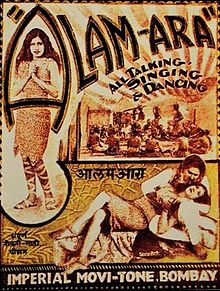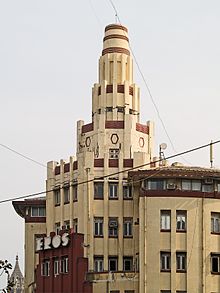Bollywood
This article is about the Hindi film industry. For the entire film culture of India, see Cinema of India. For the tree species, see Bollywood (tree).
Bollywood is the sobriquet for the Hindi language film industry based in Mumbai, themost populous city of the Republic of India.[3][4] The term is often loosely used as asynecdoche to refer to the whole of Indian cinema; however, Bollywood proper is only a part of the large Indian film industry, which includes other production centres producing films in many languages.[5]
Bollywood is one of the largest film producers in India, representing 43% of net box office revenue, while Telugu cinema, and Tamil cinema representing 36%, and rest of the regional cinema constitutes 21% as of 2014,[6]Bollywood is also one of the largest centers of film production in the world.[7][8][9] It is more formally referred to as Hindi cinema.[10]Bollywood is one of the biggest movie industries in the world in terms of the number of people employed and the number of films produced.[11] In 2011, over 3.5 billion tickets were sold across the globe which in comparison is 900,000 tickets more thanHollywood.[12] Bollywood produced 252 films in 2014 out of the total 1969 films produced in India.
Etymology
The name "Bollywood" is a portmanteauderived from Bombay (the former name for Mumbai) and Hollywood, the center of theAmerican film industry.[13] However, unlike Hollywood, Bollywood does not exist as a physical place. Some deplore the name, arguing that it makes the industry look like a poor cousin to Hollywood.[13][14]
The naming scheme for "Bollywood" was inspired by "Tollywood", the name that was used to refer to the cinema of West Bengal. Dating back to 1932, "Tollywood" was the earliest Hollywood-inspired name, referring to the Bengali film industry based in Tollygunge,Calcutta, whose name is reminiscent of "Hollywood" and was the centre of the cinema of India at the time.[15] It was this "chance juxtaposition of two pairs of rhyming syllables," Holly and Tolly, that led to the portmanteau name "Tollywood" being coined. The name "Tollywood" went on to be used as a nickname for the Bengali film industry by the popular Kolkata-based Junior Statesmanyouth magazine, establishing a precedent for other film industries to use similar-sounding names, eventually leading to the term "Bollywood" being coined.[16] However, more popularly, Tollywood is now used to refer to the Telugu Film Industry in Telangana &Andhra Pradesh. The term "Bollywood" itself has origins in the 1970s, when India overtook America as the world's largest film producer. Credit for the term has been claimed by several different people, including the lyricist, filmmaker and scholar Amit Khanna,[17] and the journalist Bevinda Collaco.[18]
History

Film poster for first Indian sound film,Ardeshir Irani's Alam Ara (1931)
Raja Harishchandra (1913), by Dadasaheb Phalke, is known as the first silent feature film made in India. By the 1930s, the industry was producing over 200 films per annum.[19]The first Indian sound film, Ardeshir Irani'sAlam Ara (1931), was a major commercial success.[20] There was clearly a huge market for talkies and musicals; Bollywood and all the regional film industries quickly switched to sound filming.
The 1930s and 1940s were tumultuous times:India was buffeted by the Great Depression,World War II, the Indian independence movement, and the violence of the Partition. Most Bollywood films were unabashedlyescapist, but there were also a number of filmmakers who tackled tough social issues, or used the struggle for Indian independence as a backdrop for their plots.[19]
In 1937, Ardeshir Irani, of Alam Ara fame, made the first colour film in Hindi, Kisan Kanya. The next year, he made another colour film, a version of Mother India. However, colour did not become a popular feature until the late 1950s. At this time, lavish romantic musicals and melodramas were the staple fare at the cinema.
Golden Age
Following India's independence, the period from the late 1940s to the 1960s is regarded by film historians as the "Golden Age" of Hindi cinema.[21][22][23] Some of the most critically acclaimed Hindi films of all time were produced during this period. Examples include the Guru Dutt films Pyaasa (1957) andKaagaz Ke Phool (1959) and the Raj Kapoorfilms Awaara (1951), Shree 420 (1955) andDilip Kumar's Aan (1952). These films expressed social themes mainly dealing with working-class urban life in India; Awaarapresented the city as both a nightmare and a dream, while Pyaasa critiqued the unreality of city life.[24] Some of the most famous epic films of Hindi cinema were also produced at the time, including Mehboob Khan's Mother India (1957), which was nominated for theAcademy Award for Best Foreign Language Film,[25] and K. Asif's Mughal-e-Azam (1960).[26]Madhumati (1958), directed by Bimal Roy and written by Ritwik Ghatak, popularised the theme of reincarnation in Western popular culture.[27] Other acclaimed mainstream Hindi filmmakers at the time included Kamal Amrohi and Vijay Bhatt. Successful actors at the time included Dev Anand, Dilip Kumar, Raj Kapoor and Guru Dutt, while successful actresses included Nargis, Vyjayanthimala,Meena Kumari, Nutan, Madhubala, Waheeda Rehman and Mala Sinha.[28]
While commercial Hindi cinema was thriving, the 1950s also saw the emergence of a newParallel Cinema movement.[24] Though the movement was mainly led by Bengali cinema, it also began gaining prominence in Hindi cinema. Early examples of Hindi films in this movement include Chetan Anand's Neecha Nagar (1946)[29] and Bimal Roy's Do Bigha Zamin (1953). Their critical acclaim, as well as the latter's commercial success, paved the way for Indian neorealism[30] and the Indian New Wave.[31] Some of the internationally acclaimed Hindi filmmakers involved in the movement included Mani Kaul, Kumar Shahani, Ketan Mehta, Govind Nihalani,Shyam Benegal and Vijaya Mehta.[24]
Ever since the social realist film Neecha Nagarwon the Grand Prize at the first Cannes Film Festival,[29] Hindi films were frequently in competition for the Palme d'Or at the Cannes Film Festival throughout the 1950s and early 1960s, with some of them winning major prizes at the festival.[32] Guru Dutt, while overlooked in his own lifetime, had belatedly generated international recognition much later in the 1980s.[32][33] Dutt is now regarded as one of the greatest Asian filmmakers of all time, alongside the more famous Indian Bengali filmmaker Satyajit Ray. The 2002Sight & Sound critics' and directors' poll of greatest filmmakers ranked Dutt at No. 73 on the list.[34] Some of his films are now included among the greatest films of all time, withPyaasa (1957) being featured in Time magazine's "All-TIME" 100 best movies list,[35]and with both Pyaasa and Kaagaz Ke Phool(1959) tied at No. 160 in the 2002 Sight & Sound critics' and directors' poll of all-time greatest films. Several other Hindi films from this era were also ranked in the Sight & Soundpoll, including Raj Kapoor's Awaara (1951),Vijay Bhatt's Baiju Bawra (1952), Mehboob Khan's Mother India (1957) and K. Asif'sMughal-e-Azam (1960) all tied at No. 346 on the list.[36]
Modern cinema
In the late 1960s and early 1970s, romance movies and action films starred actors likeRajesh Khanna, Dharmendra, Sanjeev Kumarand Shashi Kapoor and actresses likeSharmila Tagore, Mumtaz and Asha Parekh. In the mid-1970s, romantic confections made way for gritty, violent films about gangsters (see Indian mafia) and bandits. Amitabh Bachchan, the star known for his "angry young man" roles, rode the crest of this trend with actors like Mithun Chakraborty, Anil Kapoor and Sunny Deol, which lasted into the early 1990s. Actresses from this era includedHema Malini, Jaya Bachchan and Rekha.[28]
Some Hindi filmmakers such as Shyam Benegal continued to produce realisticParallel Cinema throughout the 1970s,[37]alongside Mani Kaul, Kumar Shahani, Ketan Mehta, Govind Nihalani and Vijaya Mehta.[24]However, the 'art film' bent of the Film Finance Corporation came under criticism during a Committee on Public Undertakings investigation in 1976, which accused the body of not doing enough to encourage commercial cinema. The 1970s thus saw the rise of commercial cinema in the form of enduring films such as Sholay (1975), which consolidated Amitabh Bachchan's position as a lead actor. The devotional classic Jai Santoshi Ma was also released in 1975.[38]Another important film from 1975 wasDeewar, directed by Yash Chopra and written by Salim-Javed. A crime film pitting "a policeman against his brother, a gang leader based on real-life smuggler Haji Mastan", portrayed by Amitabh Bachchan; it was described as being "absolutely key to Indian cinema" by Danny Boyle.[39] The most internationally acclaimed Hindi film of the 1980s was Mira Nair's Salaam Bombay!(1988), which won the Camera d'Or at the1988 Cannes Film Festival and was nominated for the Academy Award for Best Foreign Language Film.
During the late 1980s and early 1990s, the pendulum swung back toward family-centric romantic musicals with the success of such films as Qayamat Se Qayamat Tak (1988),Maine Pyar Kiya (1989), Dil (1990), Hum Aapke Hain Kaun (1994), Dilwale Dulhania Le Jayenge(1995) and Kuch Kuch Hota Hai (1998) making stars of a new generation of actors (such asAamir Khan, Salman Khan and Shahrukh Khan) and actresses (such as Madhuri Dixit,Sridevi, Juhi Chawla).[28] In that point of time, action and comedy films were also successful, with actors like Govinda and actresses such as Raveena Tandon andKarisma Kapoor appearing in popular comedy films, and stunt actor Akshay Kumar gaining popularity for performing dangerous stunts inaction films in his well known Khiladi (film series) and other action films.[40][41]Furthermore, this decade marked the entry of new performers in arthouse and independent films, some of which succeeded commercially, the most influential example being Satya (1998), directed by Ram Gopal Varma and written by Anurag Kashyap. The critical and commercial success of Satya led to the emergence of a distinct genre known as Mumbai noir,[42] urban films reflecting social problems in the city of Mumbai.[43] This led to a resurgence of Parallel Cinema by the end of the decade.[42] These films often featured actors like Nana Patekar, Manoj Bajpai, Manisha Koirala, Tabu and Urmila Matondkar, whose performances were usually critically acclaimed.

Bollywood actor Salman Khan with actresses (from left)Kareena Kapoor, Rani Mukerji, Preity Zinta, Katrina Kaif,Karisma Kapoor and Priyanka Chopra, in Mumbai, 2010.
The 2000s saw a growth in Bollywood's popularity across the world. This led the nation's filmmaking to new heights in terms of production values, cinematography and innovative story lines as well as technical advances in areas such as special effects and animation.[44] Some of the largest production houses, among them Yash Raj Films and Dharma Productions were the producers of new modern films.[44] Some popular films of the decade were Koi... Mil Gaya (2003), Kal Ho Naa Ho (2003), Veer-Zaara(2004), Dhoom (2004), Hum Tum (2004),Dhoom 2 (2006), Krrish (2006), and Jab We Met(2007). These films starred established actors. However, the mid-2000s also saw the rise of popular actors like Hrithik Roshan, Saif Ali Khan, Shahid Kapoor, and Abhishek Bachchan, as well as actresses like Rani Mukerji, Preity Zinta, Aishwarya Rai, Kareena Kapoor, and Priyanka Chopra.
In the early 2010s, established actors likeSalman Khan and Akshay Kumar became known for making big-budget masalaentertainers like Dabangg and Rowdy Rathoreopposite younger actresses like Sonakshi Sinha. These films were often not the subject of critical acclaim, but were nonetheless major commercial successes. While most stars from the 2000s continued their successful careers into the next decade, the 2010s also saw the rise of a new generation of actors like Ranbir Kapoor, Imran Khan,Ranveer Singh, and Arjun Kapoor, as well as actresses like Vidya Balan, Katrina Kaif,Deepika Padukone, Kangana Ranaut,Anushka Sharma, and Parineeti Chopra.
Hindi films can achieve distribution across at least 22 of India’s 29 states.[45] The Hindi film industry has preferred films that appeal to all segments of the audience (see the discussion in Ganti, 2004, cited in references), and has resisted making films that target narrower audiences. It was believed that aiming for a broad spectrum would maximise box office receipts. However, filmmakers may be moving towards accepting some box-office segmentation, between films that appeal to rural Indians, and films that appeal to urban and international audiences.
https://linksredirect.com/?pub_id=11719CL10653&subid=5&url=https%3A//linksredirect.com/%3Fpub_id%3D11719CL10653%26url%3Dhttp%3A//www.americanswan.com/

No comments:
Post a Comment